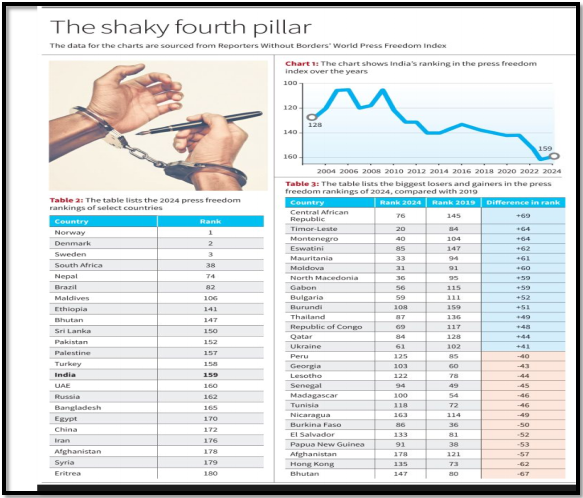THE GROWING PROBLEM OF RESTRICTED ACCESS
Relevance
- GS 2 – Governance, Media and Society
Context:
The space for journalists is being squeezed in Parliament and government functions, raising concerns about transparency and media freedom.
The Press Gallery Experience
- Enhanced Security Measures:
- Last month, while covering Prime Minister Narendra Modi’s speech in the Rajya Sabha, journalists noticed an unusual level of scrutiny from young security personnel in grey civvies, closely following their hand movements and notes.
- This intense scrutiny began after the Central Industrial Security Force (CISF) took over Parliament security post a breach in December 2023. The scale of deployment and level of scrutiny in the press gallery have significantly increased.
- Restricted Access Post-COVID-19:
- Entry into the press gallery has been heavily restricted since the COVID-19 pandemic. Only two journalists from each organization are allowed at a time.
- The new Parliament building segregates spaces for journalists, officials, and Members of Parliament (MPs), unlike the old Parliament where such divisions didn’t exist.
Impact on Journalists
- Increased Frisking and Movement Restrictions:
- Journalists face multiple frisking points and have to walk down long, windowless corridors with security cameras to reach the gallery.
- Earlier this week, TV journalists and camerapersons were confined to an air-conditioned glass enclosure, restricting their movement around Parliament.
- Inconveniences and Isolation:
- Incidents like farm leaders coming to meet Rahul Gandhi and causing inconvenience to MPs highlight the increasing challenges journalists face in accessing newsworthy areas.
- The necessity of journalists in Parliament is underscored by their ability to capture interactions, camaraderie, and behind-the-scenes activities that Sansad TV cannot.
Government Functions
- Restricted Interaction with Officials:
- At government functions, traditional spaces where journalists could interact with officials have been blocked.
- Security personnel now prevent journalists from entering VIP enclosures, further limiting their access to firsthand information and candid conversations.
- Symbolic Gestures: At one function, journalists were told they could only attend for “tea and snacks,” reflecting the perception of media access being trivialized.
Broader Implications
- Impact on Media Freedom:
- Restricted access to Parliament and government functions may give politicians and bureaucrats temporary relief from scrutiny, but it undermines the media’s role in democracy.
- Democracies thrive on an inquisitive media landscape, and limiting journalists’ access threatens transparency and accountability.
- Long-Term Consequences:
- The trend of reducing journalists’ access could lead to less informed public discourse and a weakening of democratic institutions.
- Ensuring that journalists have the freedom to report on government activities is essential for maintaining a healthy democracy.
| UPSC Perspective
Importance for GS 2 (Governance):
Ethics and Integrity:
Statistical Data
|
Case Studies
- International Comparisons:
- In the United States, journalists have significant access to government proceedings, with regular press briefings and opportunities to question officials directly. This level of access is critical for maintaining transparency and holding the government accountable.
- In contrast, countries with restricted media access often experience higher levels of corruption and lower levels of public trust in government. The lack of transparency in these countries can lead to misinformation and a lack of accountability.
- Historical Precedents: During the Emergency period in India (1975-1977), press freedom was severely curtailed, leading to widespread censorship and a significant decline in the quality of public information. The post-Emergency period saw a restoration of press freedoms, highlighting the importance of an independent media for democracy.
Conclusion
The increasing restrictions on journalists in Parliament and government functions pose significant challenges to media freedom and transparency. It is crucial for democratic health that these barriers are addressed to ensure journalists can perform their essential role in society.
Mains Question
Evaluate the impact of restricted access for journalists in Parliament and government functions on transparency and accountability in governance. How can the government balance security concerns with the need for media freedom? (250 words)
Source: The Hindu




